The Roux Trick For A More Flavorful Chicken Stew
Over in the beautiful foodie land known as France, they have what are known as the Five Mother Sauces. These sauces are béchamel, velouté, Espagnole, hollandaise, and tomato, and they serve as the building blocks for French cooking and the cuisine's influence on the world. An interesting fact about the Mother Sauces is that four of the five share the same base. A roux is required to make béchamel, velouté, espagnole, and tomato sauce. The outlier is hollandaise sauce, made from egg yolks, lemon juice, and butter.
A traditional French roux, first developed in the 17th century according to the Michelin Guide, is a simple combination of equal parts fat — typically butter or lard — and flour, cooked together to form a light paste. Roux also plays a significant role in Cajun country cooking. Cajuns, descended from North American French colonists, make roux using whatever fat is on hand and cook it for a very long time in a heavy-bottomed pot until roux is a dark, chocolatey color, according to The Spruce Eats. We know you're not looking to spend hours stirring together fat and flour for your next meal, so we have a quick roux trick you can use to dial the flavor of your next chicken stew.
Unlock hidden flavor potential
Every culture has its own version of chicken stew. The Acadian people of northern New England and eastern Canada have Chicken Fricot. The West Africans have chicken and peanut stew. The Italians have pollo alla cacciatora, or Hunter's Wife Chicken. The French have the classic coq au vin. Numerous chicken curries exist throughout Asia. The point is that no matter where you are in the world, if chickens are raised, someone has turned them into a stew (via Saveur).
As we've learned, combining fat and flour makes a roux. Serious Eats notes that when making South Carolina-style Lowcountry chicken, you can deepen the flavor of your roux by using the remaining fat in the pan from browning the chicken. The roux will gently thicken the stew to the consistency of a light gravy, clinging to the flavors of the chicken fat and the aromatics of the dish. As the roux dissolves into the sauce and thickens the stew, all of the locked-in flavors are released, leaving you with a thick, beautiful, savory stew. And this trick needn't be reserved for chicken stew; you can do this with whatever stew recipe is closest to your heart!

